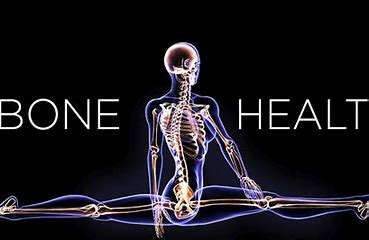
bone health
By Laura Burk MPH, RDN, LDN
Personal trainer and yoga instructor
We need to take care of our bone health. The repetitive motion of exercise may cause wear and tear on our bodies breaking down muscles and especially bones.
Bones play many roles in the body — providing structure, protecting organs, anchoring muscles and storing calcium. It’s important to build strong and healthy bones during childhood and adolescence, it’s imperative to maintain our bone health during adulthood to protect our bone mass.
Why is bone health important?
Your bones are continuously changing — new bone is made, and old bone is broken down. When you’re young, your body makes new bone faster than it breaks down old bone, and your bone mass increases. Most people reach their peak bone mass around age 30. After that, bone remodeling continues, but you lose slightly more bone mass than you gain. We need to maintain our bone mass to prevent osteoporosis, stress reactions, and stress fractures.
Osteoporosis is a common disease that weakens bones. As bones weaken, your risk of sudden and unexpected fractures increases. Stress fractures are tiny cracks in a bone. They’re caused by repetitive force, often from overuse — such as running long distances. Stress fractures can also arise from normal use of a bone that’s weakened by osteoporosis.
What affects bone mass and bone health?
- Amount of calcium and vitamin D in your diet
- Physical activity
- Tabaco and alcohol use
- Gender, Size, and Age
- Race and family history
- Hormone levels
- Eating disorders
- Medications
How much calcium do I need to eat to keep my bones healthy?
For adults ages 19 to 50 and men ages 51 to 70, the recommended dietary allowance (RDA) is 1,000 milligrams (mg) of calcium a day. The recommendation increases to 1,200 mg a day for women after age 50 and for men after age 70.
Foods that are high in calcium
- Milk – 1 cup equals 300mg of calcium
- Yogurt -1 cup equals 300mg of calcium
- Swiss Cheese – 1-ounce equals 270mg
- Eggs
- Kale and spinach – 1 cup equals 90mg
- Collard greens and broccoli – 1 cup equals 90mg
- Kelp
- Sardines- 3 ounces equals 320 mg
- Soy beans
- White beans
- Whole grain foods
- Oranges – ¾ cup equals 200mg
- Rainbow trout
- Almonds – 1 ounces equals 76mg
How much Vitamin D do I need to eat to keep my bones healthy?
Your body needs vitamin D to absorb calcium. For adults ages 19 to 70, the RDA of vitamin D is 600 international units (IUs) a day. The recommendation increases to 800 IUs a day for adults age 71 and older.
- Shiitake and Button Mushrooms
- Mackerel -3 ounces is 90% of your vitamin D needs
- Sockeye Salmon – 3 ounces are 90% of your vitamin D needs
- Herring
- Sardines- 1 small tin can provide 101% of your daily need
- Catfish
- Tuna- 6 ounces of tuna daily to obtains 50% of your vitamin D needs
- Cod Liver Oil- 1 tsp offers 113% of your daily vitamin D
- Eggs – 1 egg provides 21% of your daily needs.
- Sunshine – When sunlight hits the skin, it stimulates the production of vitamin D from cholesterol. This is great news for those of us that like to run on warm sunny days.
To maintain your bone health, make sure you are eating high calcium foods along with high vitamin D foods.

